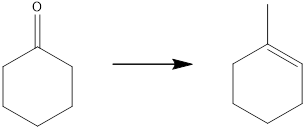
Concept explainers
(a)
Interpretation:
An efficient synthesis that can be used to achieve each of the following transformations is to be determined.

Concept introduction:
The product molecule has one more carbon atom than the starting material. For the generation of tertiary alcohol from secondary alcohol, there must be oxidation of alcohol to the carbonyl group, after which, there must be an addition of a methyl fragment, preferably using a Grignard reagent. This after hydrolysis can yield the desired tertiary alcohol.
(b)
Interpretation:
An efficient synthesis that can be used to achieve each of the following transformations is to be determined.

Concept introduction: The final product has one more carbon atom than the starting material. This can be facilitated by the addition of a methyl group, preferably using a Grignard reagent after conversion of
(c)
Interpretation:
The efficient synthesis that can be used to achieve the following transformation is to be determined.

Concept introduction:
The final product contains two additional carbon atoms, so the synthesis requires a carbon-carbon bond-forming reaction. To facilitate this, the desired product should be produced by oxidizing the generated alcohol using the proper Grignard reagent.
(d)
Interpretation:
The efficient synthesis that can be used to achieve each of the following transformations is to be determined.

Concept introduction:
The target molecule contains one additional carbon atom, so the synthesis must have a carbon-carbon bond-forming reaction. This can be achieved by using a Grignard reagent followed by an elimination reaction which can yield the desired unsaturated product.
(e)
Interpretation:
The efficient synthesis that can be used to achieve each of the following transformations is to be determined.

Concept introduction:
The target molecule contains three additional carbon atoms, so the reaction needs a Carbon−Carbon bond-forming reaction. The
(f)
Interpretation:
An efficient synthesis that can be used to achieve each of the following transformations is to be determined.

Concept introduction:
The target molecule has two additional phenyl groups, which can be done by adding Grignard reagent containing phenyl groups two times, followed by oxidation. The starting material contains carbonyl carbon which is the reaction center for the phenyl part of the Grignard reagent.
Want to see the full answer?
Check out a sample textbook solution
Chapter 12 Solutions
ORGANIC CHEMISTRY LL PRINT UPGRADE
- 20.35 Propose structural formulas for compounds A and B and specify the configuration of compound B. EtO₂C 250°C C14H2004 CO₂Et 1. Oso, then NaHSO3 2. HIO4 C14H2006 A Barrow_forward20.21 Predict the major product formed by 1,4-addition of HCI to cyclopentadiene. 20.22 Draw structural formulas for the two constitutional isomers with the molecular for- mula C₂H,Br, formed by adding one mole of Br, to cyclopentadiene.arrow_forwardAdd substituents to draw the conformer below (sighting down the indicated bond), then rotate the back carbon to provide the conformation that will be capable of an E2 elimination. R/S stereochemistry is graded. + I I H CH3 Ph Досн Br OCH 3 Drawing Q H Atoms, Bonds and Rings Charges Tap a node to see suggestions. H H H H H Undo Reset Remove Done Rotatearrow_forward
- 20.17 Predict the structure of the major product formed by 1,2-addition of HBr to 3-methylenecyclohexene. 3-Methylenecyclohexene 20.18 Predict the major product formed by 1,4-addition of HBr to 3-methylenecyclohexene.arrow_forward+ Draw a vicinal alkyl bromide that would produce the following alkene in an E2 elimination. Use a dash or wedge bond to indicate stereochemistry on asymmetric centers, where applicable. Ignore any inorganic byproducts. Br Drawing Strong Base H Q Atoms, Bonds Charges and Rings Draw or tap a new bond to see suggestions. Remove Done 語 Reset Undo + Drag To Panarrow_forwardDraw a vicinal alkyl bromide that would produce the following alkene in an E2 elimination. Use a dash or wedge bond to indicate stereochemistry on asymmetric centers, where applicable. Ignore any inorganic byproducts. + Drawing Į Strong Base H Br Q Atoms, Bonds and Rings Charges Draw or tap a new bond to see suggestions. Undo Reset 謂 Remove Done Drag To Pan +arrow_forward
- Draw the product of the E2 reaction shown below. Include the correct stereochemistry. Ignore any inorganic byproducts. + Br CH3 Q Strong Base Drawing Atoms, Bonds and Rings Charges Undo Reset H "Br H N Br. Remove Done .N. Drag To Panarrow_forwardCurved arrows are used to illustrate the flow of electrons. Use the reaction conditions provided and follow the curved arrows to draw the product of this elementary step in an elimination mechanism. Include all lone pairs and charges as appropriate. Ignore stereochemistry. Ignore byproducts. + Br: .. 8 0.01 M NaOH heat Drawing Q Atoms, Bonds and Rings Charges and Lone Pairs Draw or tap a new bond to see suggestions. Undo Reset Remove Done + Drag To Panarrow_forward+ Draw the product of the E2 reaction shown below. Include the correct stereochemistry. Ignore any inorganic byproducts. Ph CH2CH3 H H3C H Br DBN [૪] Drawing Atoms, Bonds and Rings H | OH Charges ―00 H. C | Undo Reset Br I Remove Done Drag To Pan +arrow_forward
- Reaction A Now the production A ΠIn the product of reaction i 12 Dear the product of actionarrow_forwardMacmillan Learnin When an unknown amine reacts with an unknown acid chloride, an amide with a molecular mass of 163 g/mol (M* = 163 m/z) is formed. In the infrared spectrum, important absorptions appear at 1661, 750 and 690 cm-1. The 13C NMR and DEPT spectra are provided. Draw the structure of the product as the resonance contributor lacking any formal charges. 13C NMR DEPT 90 200 160 120 80 40 0 200 160 120 80 DEPT 135 200 160 120 80 40 0 Draw the unknown amide. 40 40 0arrow_forwardDraw the major product karmed when I reach with the epoxide. Use walge dah bonds, including hydrogen al alcach genic center, to show the chemistry of the product Beeldraw any hydrogen akams on coxygen where applicablearrow_forward

 Organic ChemistryChemistryISBN:9781305580350Author:William H. Brown, Brent L. Iverson, Eric Anslyn, Christopher S. FootePublisher:Cengage Learning
Organic ChemistryChemistryISBN:9781305580350Author:William H. Brown, Brent L. Iverson, Eric Anslyn, Christopher S. FootePublisher:Cengage Learning

